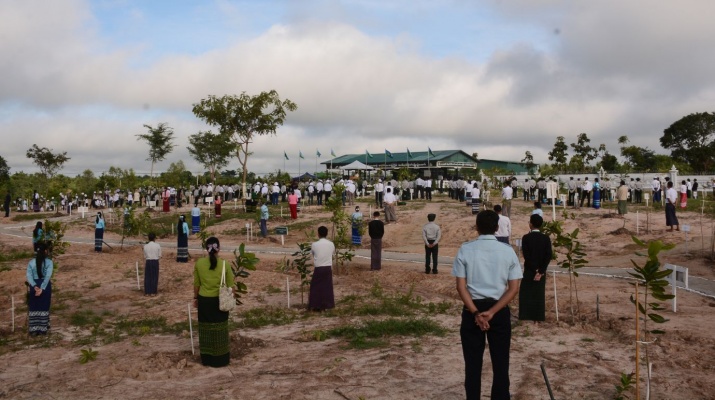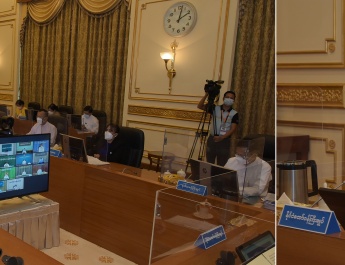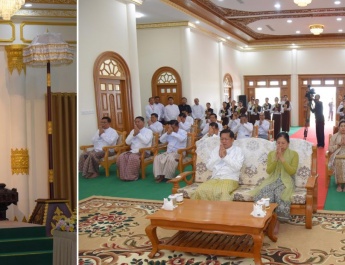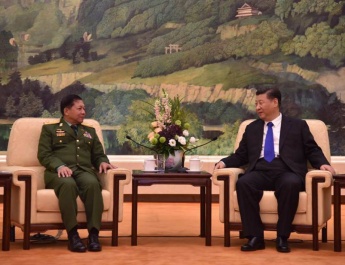NAY PYI TAW September 16
The third monsoon tree-planting ceremony for 2025 of Nay Pyi Taw, Union Territory took place near the premises of Maravijaya Buddha Image in Dekkhinathiri Township, Nay Pyi Taw, Union Territory this morning. Acting President of the Republic of the Union of Myanmar, Chairman of State Security and Peace Commission of the Republic of the Union of Myanmar, Senior General Min Aung Hlaing took part in the ceremony and planted a star-flower sapling.
Also present were Vice Chair-man of the Commission Vice-Senior General Soe Win, Com-mission member Executive Chief U Aung Lin Dway, Commission Secretary Joint Executive Chief General Ye Win Oo, Commission members, union level dignitaries, union ministers, the Nay Pyi Taw Council chair, senior military officers from the Office of the Commander-in-Chief, the Nay Pyi Taw Command commander, deputy ministers, civil servants including officers from the ministries, teachers and students of Naypyitaw State Academy, Naypyitaw State Polytechnic University, Government Technical Institute (Nay Pyi Taw), Forestry and Environmental Science University and basic education schools and officials.
First, the Senior General delivered an address. He said the State is taking the leading role in holding tree-planting ceremonies with the aim of greening and beautifying the environment, improving and balancing the ecosystem, preventing natural disasters, improving climate in accord with the motto, “Let us protect our environment for the prosperity of the Nation” with the participation of the public.
At this ceremony 3,000 shade-trees of 18 species that blossom colourful and aromatic flowers would be grown, and the ceremony is held under a special program. Trees are specifically planted in the premises where Maravijaya Buddha Image, world’s tallest marble Buddha statue in sitting posture, is located. The venue is specially chosen to turn it into a luxuriant and fragrant worshiping place, with masses of blossoming flowers. Eighteen species including gumkino, star-flower, gangkao, sal tree, neem, sakawa, Panamanian laburnum and swedaw would be planted.
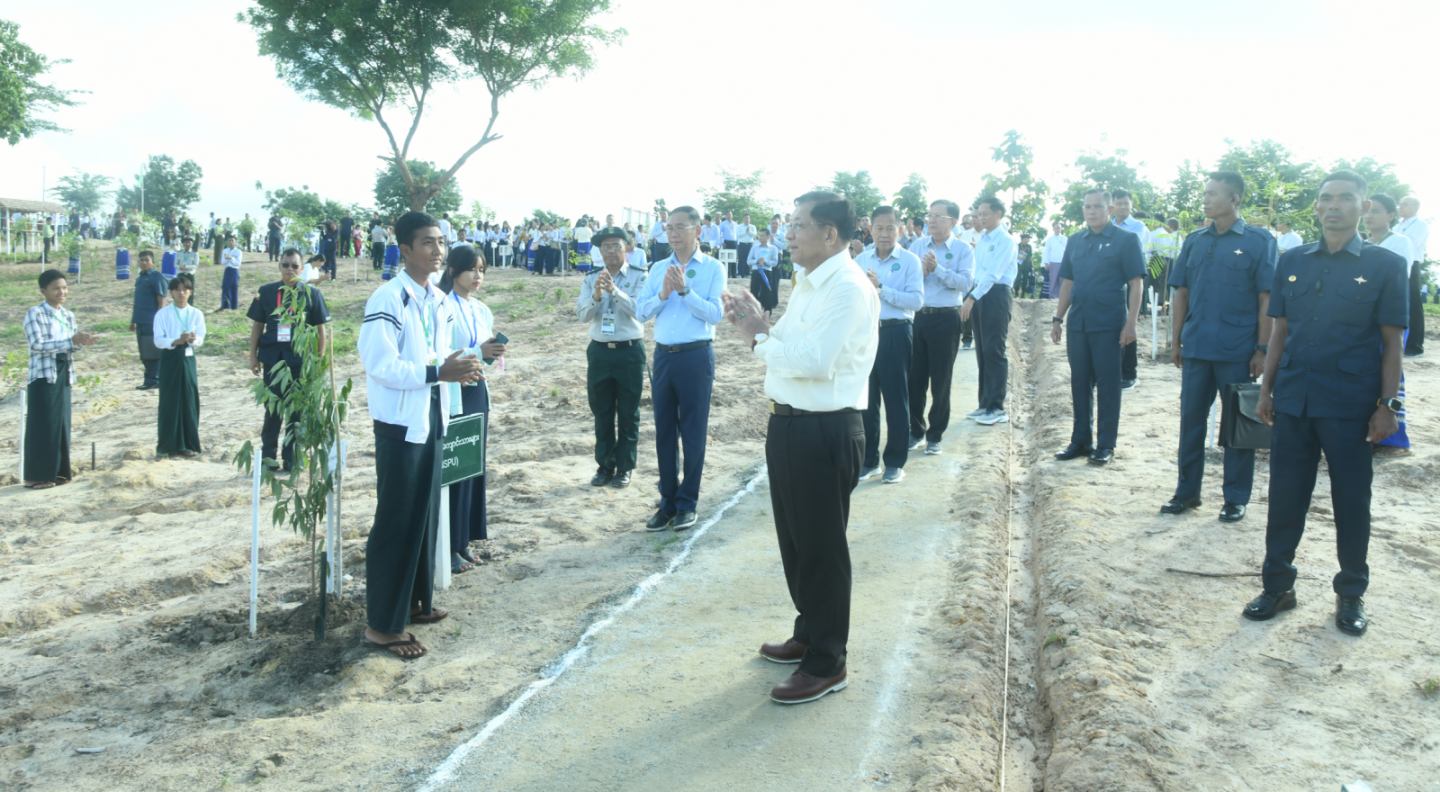
A special event of this year is the simultaneous holding of the first national-level tree-planting ceremony for greening the 13 arid districts that are in Sagaing, Magway and Mandalay regions as a mass movement on 11 July. The movement grew nearly 35,000 saplings in 29 townships.
At the second movement, 1,000 trees of seven species were grown on both sides along Minbu-Padan-An road on 19 August. The Ministry of Natural Resources and Environmental Conservation had also planted a total of 21.879 million trees including at the State-own plan tations in the entire country this monsoon. It is so encouraging.
Trees and forests are the one and only ecosystem that produce oxygen for life on earth including humans. So, they are hailed as the life supporting system. Woods also mitigate global warming and climate change and prevent natural disasters. As the flora also pro-vides ecosystem services, which are soil and water preservation and food sufficiency, systematic growing and management of trees will definitely support and benefit the environmental greening activities and sustainable national development.
In order to increase forest coverage across the nation, efforts must be made to successfully implement plans such as the Myanmar Forests Rehabilitation Plan, the Greening Project for 13 Tropical Districts, and the Integrated Management Plan for Coastal Mangrove Forests, in line with the set objectives. Similarly, for rural populations, two-acre plantations per village, village fuel-wood plantations, and multi-purpose plantations must be established. Shade trees and small forest patches must be planted along the sides of roads, including the ASEAN roadside, Union highway roadside, and the Yangon-Mandalay Express-way roadside. Furthermore, the planting and maintenance of trees along railway lines, on bare hills and mountain tops, in watershed areas of rivers and streams, and in natural water source areas must be accelerated and implemented.
In reality, tree planting is not just for festivals and ceremonies like this; it is an existing routine and traditional practice in nature. If every individual, family, or organization annually plants and nurtures as many trees as they can one, two, three, etc… to ensure survival in their home compounds, around their houses, in their wards/villages, around their farms, around their factories and workshops, and in any reachable places, then our goal of achieving 50 percent forest coverage in the country, along with the development of forests and trees and greening efforts, will undoubtedly progress. This task is a routine activity, not overly burdensome, and does not involve great hardship. If we do it and can do it, it will be a highly beneficial and meritorious act. I would like to mention that today’s tree planting ceremony aims to eternally honor the Lord Buddha by planting perennial trees rich in colour, appearance, and fragrance; therefore, I urge everyone to make special efforts to ensure they survive and thrive.
In accordance with the national policy of “Let’s protect our environment for the prosperity of the Nation,” I urge that, including the Nay Pyi Taw Council area, continuous emphasis be placed on increasing the planting and establishment of trees and forests, green and lush forest landscapes, and green spaces in urban and rural areas across the nation. Everyone, every household, every village, and every ward must be mobilized to plant trees. All must collectively nurture and maintain every tree planted at the cost of time, manpower, and money, ensuring each one survives. I encourage all citizens to participate collaboratively in the systematic planting, maintenance, and management of trees and forests across the country as a national duty.
Following this, Senior General Min Aung Hlaing led the planting of a star-flower sapling in the designated area.
Subsequently, Vice-Senior General Soe Win, Commission Member Executive Chief U Aung Lin Dway, Commission Secretary Joint Executive Chief General Ye Win Oo, Union-level officials, Union Ministers, invited distinguished guests, students, and responsible personnel from ministries and departments planted saplings simultaneously.
Afterwards, the Senior General toured the site, encouraging the participants who were cheerfully planting the saplings at the 2025 Third Monsoon Tree Planting Ceremony.
At today’s ceremony, 3,000 saplings of 18 tree species, including shade trees that bloom with colorful and frag-rant flowers such as Padauk, star-flower, Gangaw, Ingyin, neem, Sakawa, Panama Ngu, and Bauhinia acuminata, were planted cheerfully together in a public movement.


